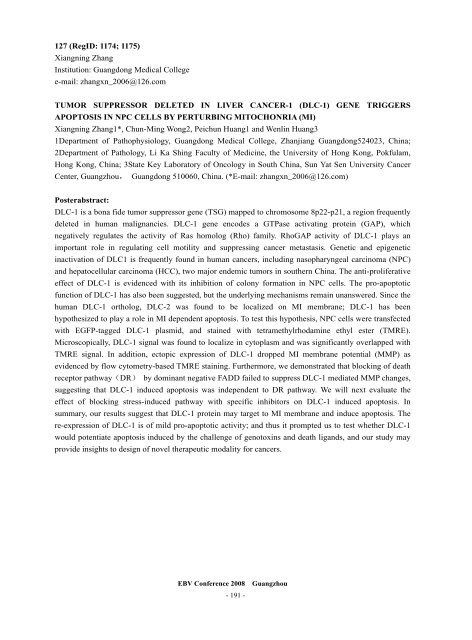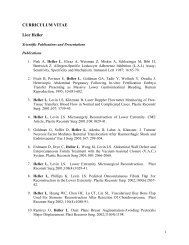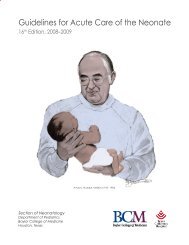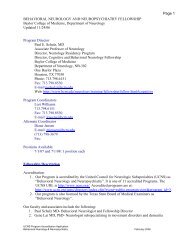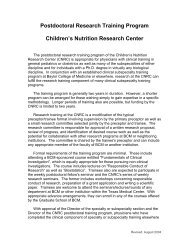EBV Conference 2008 Guangzhou - Baylor College of Medicine
EBV Conference 2008 Guangzhou - Baylor College of Medicine
EBV Conference 2008 Guangzhou - Baylor College of Medicine
You also want an ePaper? Increase the reach of your titles
YUMPU automatically turns print PDFs into web optimized ePapers that Google loves.
127 (RegID: 1174; 1175)<br />
Xiangning Zhang<br />
Institution: Guangdong Medical <strong>College</strong><br />
e-mail: zhangxn_2006@126.com<br />
TUMOR SUPPRESSOR DELETED IN LIVER CANCER-1 (DLC-1) GENE TRIGGERS<br />
APOPTOSIS IN NPC CELLS BY PERTURBING MITOCHONRIA (MI)<br />
Xiangning Zhang1*, Chun-Ming Wong2, Peichun Huang1 and Wenlin Huang3<br />
1Department <strong>of</strong> Pathophysiology, Guangdong Medical <strong>College</strong>, Zhanjiang Guangdong524023, China;<br />
2Department <strong>of</strong> Pathology, Li Ka Shing Faculty <strong>of</strong> <strong>Medicine</strong>, the University <strong>of</strong> Hong Kong, Pokfulam,<br />
Hong Kong, China; 3State Key Laboratory <strong>of</strong> Oncology in South China, Sun Yat Sen University Cancer<br />
Center, <strong>Guangzhou</strong>, Guangdong 510060, China. (*E-mail: zhangxn_2006@126.com)<br />
Posterabstract:<br />
DLC-1 is a bona fide tumor suppressor gene (TSG) mapped to chromosome 8p22-p21, a region frequently<br />
deleted in human malignancies. DLC-1 gene encodes a GTPase activating protein (GAP), which<br />
negatively regulates the activity <strong>of</strong> Ras homolog (Rho) family. RhoGAP activity <strong>of</strong> DLC-1 plays an<br />
important role in regulating cell motility and suppressing cancer metastasis. Genetic and epigenetic<br />
inactivation <strong>of</strong> DLC1 is frequently found in human cancers, including nasopharyngeal carcinoma (NPC)<br />
and hepatocellular carcinoma (HCC), two major endemic tumors in southern China. The anti-proliferative<br />
effect <strong>of</strong> DLC-1 is evidenced with its inhibition <strong>of</strong> colony formation in NPC cells. The pro-apoptotic<br />
function <strong>of</strong> DLC-1 has also been suggested, but the underlying mechanisms remain unanswered. Since the<br />
human DLC-1 ortholog, DLC-2 was found to be localized on MI membrane; DLC-1 has been<br />
hypothesized to play a role in MI dependent apoptosis. To test this hypothesis, NPC cells were transfected<br />
with EGFP-tagged DLC-1 plasmid, and stained with tetramethylrhodamine ethyl ester (TMRE).<br />
Microscopically, DLC-1 signal was found to localize in cytoplasm and was significantly overlapped with<br />
TMRE signal. In addition, ectopic expression <strong>of</strong> DLC-1 dropped MI membrane potential (MMP) as<br />
evidenced by flow cytometry-based TMRE staining. Furthermore, we demonstrated that blocking <strong>of</strong> death<br />
receptor pathway(DR) by dominant negative FADD failed to suppress DLC-1 mediated MMP changes,<br />
suggesting that DLC-1 induced apoptosis was independent to DR pathway. We will next evaluate the<br />
effect <strong>of</strong> blocking stress-induced pathway with specific inhibitors on DLC-1 induced apoptosis. In<br />
summary, our results suggest that DLC-1 protein may target to MI membrane and induce apoptosis. The<br />
re-expression <strong>of</strong> DLC-1 is <strong>of</strong> mild pro-apoptotic activity; and thus it prompted us to test whether DLC-1<br />
would potentiate apoptosis induced by the challenge <strong>of</strong> genotoxins and death ligands, and our study may<br />
provide insights to design <strong>of</strong> novel therapeutic modality for cancers.<br />
<strong>EBV</strong> <strong>Conference</strong> <strong>2008</strong> <strong>Guangzhou</strong><br />
- 191 -


